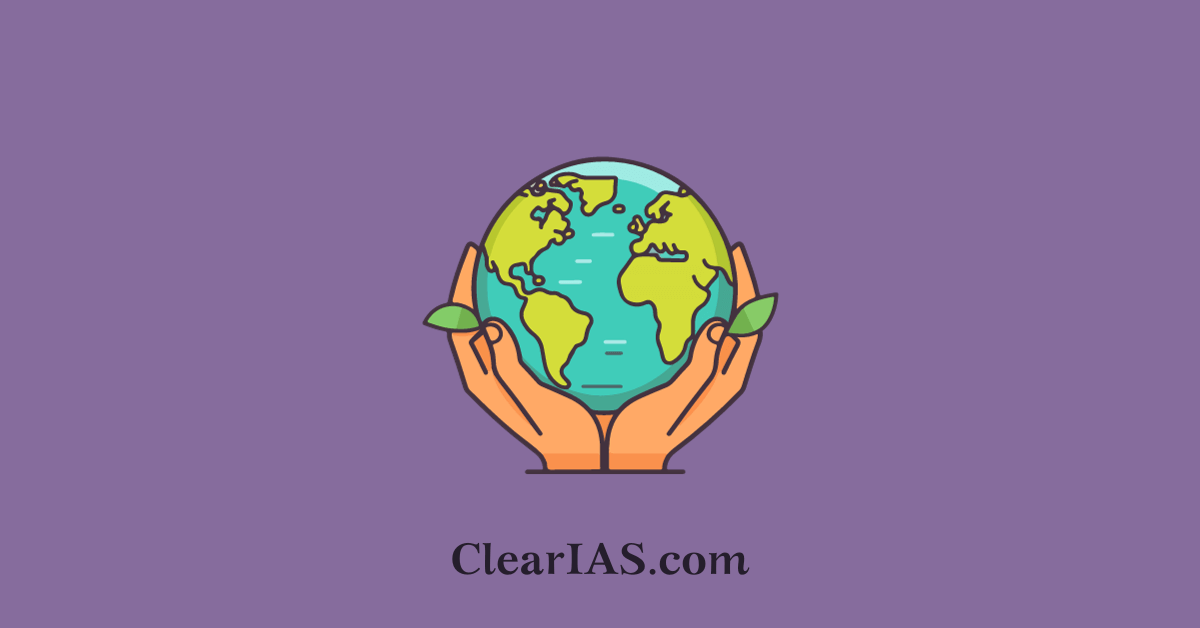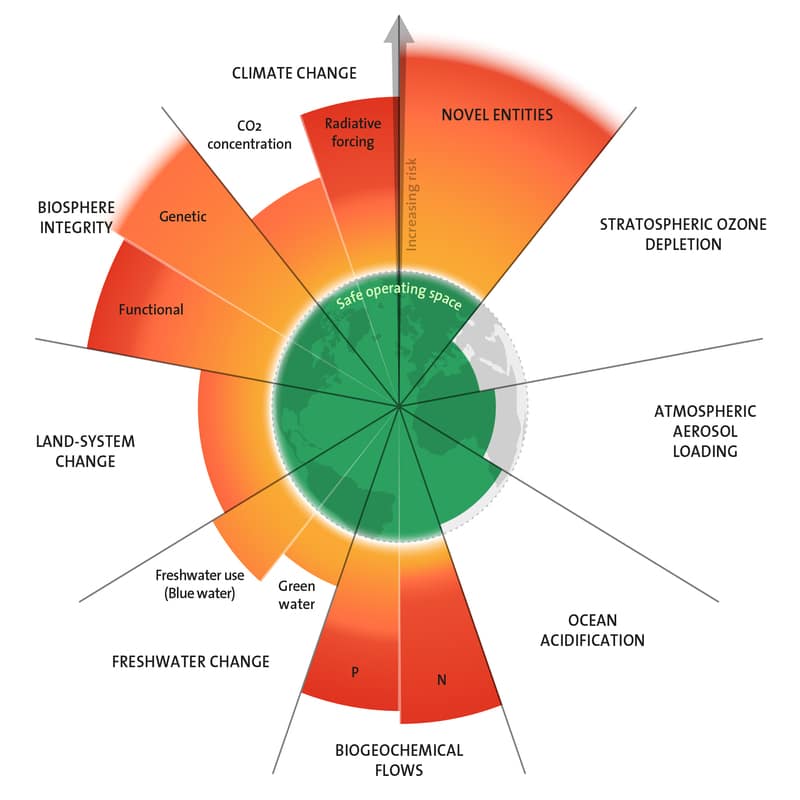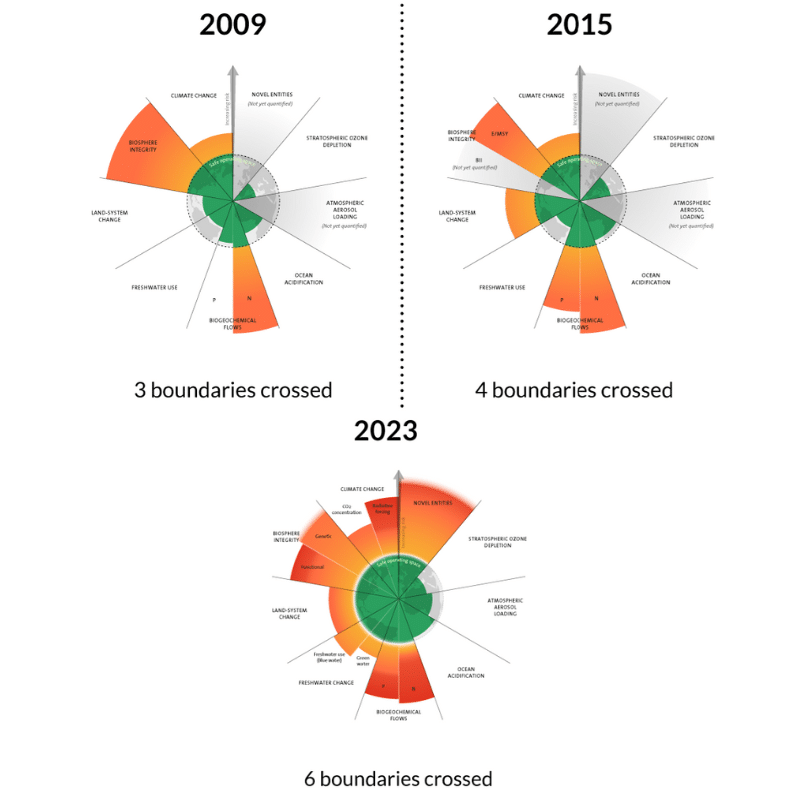
The concept of planetary boundaries presents a set of nine planetary boundaries within which humanity can continue to develop and thrive. The concept was first introduced in 2009. The latest update has quantified all boundaries and concluded that six of the nine boundaries have been transgressed. Read here to learn more.
In September 2023, a team of scientists quantified, for the first time, all nine processes that regulate the stability and resilience of the Earth system.
Crossing boundaries increases the risk of generating large-scale abrupt or irreversible environmental changes.
Drastic changes will not necessarily happen overnight, but together the boundaries mark a critical threshold for increasing risks to people and the ecosystems we are part of.
Planetary boundaries
Planetary boundaries, often referred to as the “Planetary Boundaries Framework,” is a concept in Earth system science and environmental studies that identifies a set of critical environmental limits beyond which human activities could disrupt the stability and functioning of the Earth’s systems.
- These boundaries help to define a safe operating space for humanity within the Earth’s ecological constraints.
- The concept was introduced by a group of scientists in 2009 and has gained recognition as a framework for understanding and addressing global environmental challenges.
Boundaries are interrelated processes within the complex biophysical Earth system.
- This means that a global focus on climate change alone is not sufficient for increased sustainability.
- Instead, understanding the interplay of boundaries, especially climate, and loss of biodiversity, is key in science and practice.
What are the nine planetary boundaries?

- Climate Change: This boundary relates to the concentration of greenhouse gases, particularly carbon dioxide (CO2) and methane (CH4), in the atmosphere. The boundary aims to limit global warming to a level that avoids catastrophic climate change impacts.
- Biosphere Integrity: This boundary focuses on the preservation of biodiversity and the integrity of ecosystems. It aims to prevent species extinctions and maintain the functioning of ecosystems, as biodiversity is crucial for ecosystem services that support human well-being.
- Stratospheric Ozone Depletion: This boundary addresses the depletion of the ozone layer in the Earth’s stratosphere, which protects living organisms from harmful ultraviolet (UV) radiation. Efforts have been made to reduce the use of ozone-depleting substances, leading to the partial recovery of the ozone layer.
- Land System Change: This boundary concerns the conversion of natural ecosystems into agricultural land, urban areas, or other forms of land use change. It aims to prevent the loss of crucial ecosystem services and the disruption of carbon and nutrient cycles.
- Freshwater Change: This boundary relates to the consumption of freshwater resources. It focuses on maintaining sustainable water use to ensure the availability of clean water for various human needs and ecosystem health.
- Biogeochemical Flows: This boundary covers the global cycling of essential elements like phosphorus and nitrogen. It seeks to prevent excessive nutrient pollution, which can lead to problems like eutrophication and harmful algal blooms in water bodies.
- Ocean Acidification: This boundary addresses the increasing acidity of the oceans due to the absorption of excess atmospheric CO2. Ocean acidification can harm marine ecosystems and fisheries.
- Atmospheric Aerosol Loading: This boundary relates to the release of human-made aerosols (tiny particles) into the atmosphere, which can have both cooling and warming effects on the climate. Managing aerosol loading is essential for understanding and mitigating climate change.
- Novel entities: This boundary pertains to the release of synthetic chemicals and pollutants (microplastics, endocrine disruptors, and organic pollutants) into the environment. It aims to reduce chemical pollution that can harm ecosystems, wildlife, and human health.
Breach of boundaries

The latest planetary boundaries framework update finds that six of the nine boundaries are transgressed, suggesting that Earth is now well outside of the safe operating space for humanity.
- The value of atmospheric CO2 concentration contributing to climate change was set at 350 parts per million (ppm) by the researchers. Currently, this has reached 417 ppm.
- For biosphere integrity, the researchers kept a limit of less than 10 extinctions per million species-years. Human-induced species extinctions have far exceeded the safe limit.
- The study estimated the extinction rate was greater than 100 extinctions per million species-years. It is estimated that around one million of the 8 million plant and animal species are threatened with extinction.
- In the last 150 years, over 10% of the genetic diversity of flora and fauna has been wiped out.
- The global forest land area has dropped below the safe limit of 75%, currently standing at only 60%.
- Both blue water (surface and groundwater) and green water (available water for plants) have experienced impacts beyond their safe thresholds.
- Flows of nutrients like phosphorus and nitrogen in the environment have surged beyond safe limits.
- Human influence on novel entities, including microplastics, endocrine disruptors, and organic pollutants, has transgressed the zero boundary.
- Stratospheric ozone depletion, aerosol loading, and ocean acidification were found to be within the planetary boundary as of now.
International initiatives
There is not a single international initiative solely dedicated to addressing breaches of planetary boundaries, several global efforts and agreements are aimed at addressing environmental challenges that contribute to or intersect with these boundaries. Some of these initiatives include:
- United Nations Sustainable Development Goals (SDGs): The SDGs, particularly Goal 13 (Climate Action), Goal 14 (Life Below Water), and Goal 15 (Life on Land), address critical aspects of planetary boundaries such as climate change, biodiversity loss, and ecosystem degradation.
- Paris Agreement: The Paris Agreement, adopted under the United Nations Framework Convention on Climate Change (UNFCCC), aims to limit global warming to well below 2 degrees Celsius above pre-industrial levels. It addresses one of the most significant planetary boundary concerns, climate change.
- Convention on Biological Diversity (CBD): The CBD focuses on preserving biodiversity and preventing its loss, directly related to the planetary boundary of biosphere integrity.
- Aichi Biodiversity Targets: These are a set of 20 global targets under the CBD, aimed at halting biodiversity loss and the degradation of ecosystems.
- Convention on International Trade in Endangered Species of Wild Fauna and Flora (CITES): CITES regulates international trade in endangered species to ensure their survival and prevent overexploitation.
- Sustainable Agriculture Initiatives: Various international initiatives, such as the Sustainable Agriculture Goals and the Global Soil Partnership, work to address planetary boundaries related to land use, agriculture, and soil degradation.
- Circular Economy Initiatives: The Ellen MacArthur Foundation and other organizations promote the transition to a circular economy to reduce waste, minimize resource depletion, and reduce the pressure on planetary boundaries related to resource use.
- Oceans and Marine Conservation: Initiatives like the United Nations Decade of Ocean Science for Sustainable Development, marine protected area networks, and efforts to combat plastic pollution in the oceans aim to address planetary boundaries related to marine ecosystems and ocean health.
- International Climate Finance: Programs like the Green Climate Fund (GCF) and the Global Environment Facility (GEF) provide financial support for climate mitigation and adaptation projects in developing countries.
- International Cooperation on Air and Water Quality: Agreements like the Convention on Long-Range Transboundary Air Pollution and the Ramsar Convention on Wetlands address air and water quality issues that can impact planetary boundaries.
- Corporate Sustainability Initiatives: Many multinational corporations have adopted sustainability goals and initiatives to reduce their environmental footprint and contribute to addressing planetary boundaries.
While these initiatives are diverse and address various aspects of planetary boundaries, there is growing recognition of the need for a more integrated approach to address the interconnected challenges of climate change, biodiversity loss, pollution, and resource depletion.
Recent development
Aquatic deoxygenation as a new planetary boundary
Authors of a new paper in Nature Ecology and Evolution, “Aquatic deoxygenation as a planetary boundary and key regulator of Earth system stability”, among whom are experts of the IOC Global Ocean Oxygen Network (GO2NE) expert working group, are calling for freshwater and marine oxygen concentrations to be recognised as a new planetary boundary.
- Oxygen is a fundamental requirement of life, and the loss of oxygen in water, referred to as aquatic deoxygenation, is a threat to life at all levels.
- The new paper emphasises the threat that deoxygenation presents to aquatic life and human society dependent on it, as we all are.
- Recognition of aquatic deoxygenation as a planetary boundary acknowledges its critical interlinkages with other boundaries and helps to focus international monitoring, research and policy efforts.
Way forward
The Planetary Boundaries Framework is intended to guide policymakers, scientists, and society in managing Earth’s resources and environment sustainably.
Crossing these boundaries could result in abrupt and potentially irreversible environmental changes, with severe consequences for human well-being.
Hence, staying within these boundaries is crucial for maintaining a stable and habitable planet for future generations.
It’s important to note that ongoing scientific research and assessments may refine the boundaries and add new dimensions to our understanding of Earth’s limits.
Achieving a sustainable future will require continued global cooperation and efforts to stay within planetary boundaries while meeting human development needs.
Also read: Prithvi Vigyan
-Article by Swathi Satish





Leave a Reply